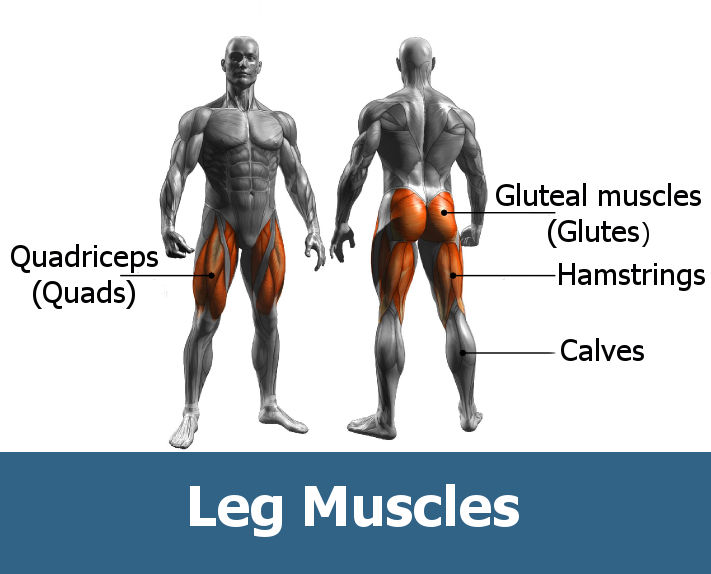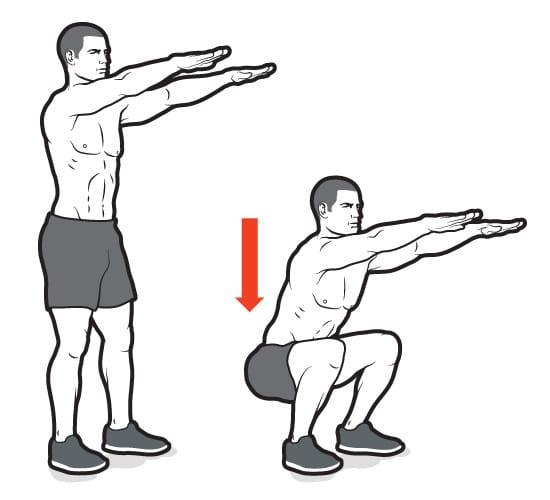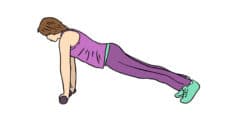The legs contain the largest muscles in the body which is why they respond so well to training in terms of growth.
Unfortunately, many people don’t appreciate this fact and favor training the biceps instead. While it’s fun, you don’t want your arms to be as big as your legs. That’s why you should always remember to train your legs.
One of the main things is understanding that such big muscles need to be trained in a different way. I will briefly try to explain the main things to focus on. From my point of view, first you need to understand the basics of what to do in training. After that, we can discuss details such as foot placement, the best exercises etc.
Structure and functions
The leg muscles can be divided into three parts: pelvis, upper leg and lower leg.
Most exercises will involve at least two of these parts. During this article, we will look closely at the first two because – lower leg training (calves) is different and I will describe it closely other time. As the legs are such a large muscle groups, they have many individual muscles arranged in two layers. We’ll look closer at what is more important for training as well as detailed workout routines later on.
Pelvic muscles. As gym goers, we tend to be more interested in the muscles located at the back of the pelvis that form your butt i.e. the gluteal muscles (gluteus maximus, medius and minimus) or simply the ‘Glutes’.
These muscles have four main functions: hip extension and abduction (leg lifting to back and to the side); keeping the trunk upright; and if the legs are fixed – straightening the body.
This muscle is used in many of our daily activities like walking, running and climbing. The faster you run – the more these muscles work. By the way, these muscles are more developed in people than “our relatives” the primates. There are several reasons for this: we walk more; we stand more in an upright position; we use tools, and we also use them for sexual attraction.
Upper legs. We will divide this area into two parts: the front and the rear.
The front contains one of the largest and strongest muscle groups known as the quadriceps (Quads). They consist of four muscles: rectus femoris, vastus medialis, vastus lateralis and vastus intermedius. Their main function is to extend the knee like when you kick someone.
In the rear are three muscles: semitendinosus, semimembranosus and biceps femoris. This group is called the hamstrings. The main function of these muscles is knee flexion such as when you move your heel closer to your butt. The hamstrings also work together with the glutes to extend the back. Examples of this are the good morning or stiff leg deadlift exercise.
Workout
Let’s begin with why everyone should train their legs. For a start, strong legs will help you to make progress in training other muscle groups. In many sports, legs are a big factor so training them will allow you to become a better athlete. Also, exercises which involve large muscle groups boost hormones such as testosterone and growth hormone secretion, both of which help with performance and overall health.
Despite all the pros, there are also cons. If the legs get too big, they can make the upper body look smaller. Also, leg workouts can be very draining and take the energy needed to train other muscle groups. Finally, heavy loads may cause problems with the knees which can create long term effects. However, this can be avoided by using the correct form and not rushing your progress.
If you want to have proportional leg muscles, you should train both of the muscle groups listed above. But there will be differences depending on your gender in terms of goals. Women tend to want shapelier butts, whereas men normally strive for thicker legs. Luckily when exercising, women’s glutes are activated better than mens’. This could explain why women can quite easily train for bigger glutes, but struggle with other areas.
To activate the leg muscles, you can either use compound (multiple muscle groups) or isolated (one muscle group) exercises. I recommend placing a greater emphasis on compound exercises, because it gives faster muscle and strength gains.
Examples of compound exercises are the squat, lunge, Romanian stiff leg deadlift, leg press, deadlift, and the step up. By changing the exercise, you can load more or less of some muscle groups. For example, if you want to hit more of the glutes – squats can be performed with wide stance or you can use the leg press with a high foot placement. If you want to highlight the quads, you can place the feet lower in the leg press and narrow your stance when squatting.
In terms of isolated exercises, the quads can be worked with leg extensions, the hamstrings with lying leg curls and the bridge (butt lift) for the glutes. Remember to periodically change exercises in order to train all parts of the area. For example, sometimes changing the back squat to the front squat or the Romanian deadlift to the Glute-Ham Raise.
Workout routines
As leg workouts are so hard, I recommend starting with simpler exercises for beginners. At first, 1-2 exercises are enough with 2-3 sets and 10 – 15 repetitions per set.
Example:
Leg press 2 sets of 10-15 reps.
Lying leg curls or Glute bridge 2 sets of 10-20 reps.
Experienced athletes are recommended to choose 2 – 4 exercises; sets: 3-4; repetitions: 6-12 or sometimes 4-20 repetitions. I strongly advise you to squat. The squat is actually known as ‘the king of exercises.’It’s extremely important for all natural bodybuilders.
Example:
Men I
Squat 3-4 sets of 6-12 reps.
Lying leg curls 2 – 4 sets of 8-12 reps.
Men II
Squat 3 sets of 4-12 reps.
Romanian deadlift 3 sets of 8-12 reps.
Leg extension 3 sets of 8-12 reps.
Women
Wide-stance squat 3 sets of 8 -15 reps.
Bridge with weight or/and
Lying leg curls 3 sets of 10-15 reps.
These are just a few examples for you to get a better idea. There are many options on how to design workouts because the routine is influenced by a range of factors such as age, sex, health, etc. Sometimes, if you already have well developed legs, then you can stick with just the squat.
It’s best not to train the legs and back together. These are both the largest muscle group, so it will place a heavy load on the body. In addition, many leg and back exercises load the lower back which can lead to pain. It’s also not considered a good idea to train the legs together with the chest muscles as they are also considered a large muscle group. But you can train them with muscle groups such as the shoulders!
Injuries
There are different leg injuries in different sports. For example, problems with the ankle and hamstring muscles will be characterized by many team sports as well as track and field disciplines, but occur much less in strength sports. To reduce the risk of traumas, each sport has been forced to develop special training programs and recommendations. That way, if you’re looking for something specific, then you’ll need to look at what is specially recommended for your sporting activity.
There’s lots of information for each sport. For example, to reduce the risk of hamstring strains, it’s recommended to perform something called the Nordic hamstring exercise. In addition, by changing the exercise technique, you can change the load on the various joints and take the pressure off the weakest area. Most injuries in the gym are usually due to performing exercises incorrectly and overload. One of the most common injuries in the gym are those associated with knee problems.
Always be careful!
When performing exercises like the squat and lunge, the knees need to follow the same direction as the feet and don’t pass the toes. For those of you using drugs, be aware of placing too much workload on the joints too quickly. You could even cause an injury during the warm-up, because your warm-up weight could be even bigger than a natural bodybuilder’s entire workout.
If you already have problems with your knees or feel pain when performing an exercise, then you should visit the appropriate doctor.
Reference:
- Chris Aceto. Championship Bodybuilding: Chris Aceto’s Instruction Book For Bodybuilding, 2001
- Effects of unilateral and bilateral lower-body heavy resistance exercise on muscle activity and testosterone responses. The Journal of Strength and Conditioning Research, 26(4), 1094-1100.
- Frederic Delavier: Strength Training Anatomy, 3rd Edition, 2010.
- Stuart McRobert. Brawn.
- Wend-Uwe Boeckh-Behrens, Wolfgang Buskies: Fitness-Krafttraining. Die besten Übungen und Methoden für Sport und Gesundheit, Rororo.
- Арнольд Шварценеггер – Новая энциклопедия бодибилдинга; Эксмо-Пресс, 2000.
- A Comparison of Quadriceps Electromyographic Activity With the Position of the Foot During the Parallel Squat. Reference
- Analysis of muscle activation during different leg press exercises at submaximum effort levels. Reference
- A Comparison of Gluteus Maximus, Biceps Femoris, and Vastus Lateralis Electromyography Amplitude in the Parallel, Full, and Front Squat Variations in Resistance-Trained Females. Reference
- A Comparison of Gluteus Maximus, Biceps Femoris, and Vastus Lateralis Electromyographic Activity in the Back Squat and Barbell Hip Thrust Exercises. Reference
- A Comparison of Gluteus Maximus, Biceps Femoris, and Vastus Lateralis Electromyography Amplitude in the Parallel, Full, and Front Squat Variations in Resistance-Trained Females. Reference
- Activity and functions of the human gluteal muscles in walking, running, sprinting, and climbing. Reference
- Are All Hip Extension Exercises Created Equal? Reference
- A literature review of studies evaluating gluteus maximus and gluteus medius activation during rehabilitation exercises. Reference
- Computational modeling of a forward lunge: towards a better understanding of the function of the cruciate ligaments. Reference
- Differences in kinematics and electromyographic activity between men and women during the single-legged squat. Reference
- Difference in the recruitment of hip and knee muscles between back squat and plyometric squat jump. Reference
- Effect of slow movement and stretch-shortening cycle on lower extremity muscle activity and joint moments during squat. Reference
- Electromyographic and kinetic comparison of the back squat and overhead squat. Reference
- Electromyographic Activity of Lower Body Muscles during the Deadlift and Still-Legged Deadlift. Journal of Exercise Physiology Online. Reference
- Electromyographic analysis of core trunk, hip, and thigh muscles during 9 rehabilitation exercises. Reference
- Electromyographical analysis of lower extremity muscle activation during variations of the loaded step-up exercise. Reference
- Electromyographic Activity of the Hamstrings During Performance of the Leg Curl, Stiff-Leg Deadlift, and Back Squat Movements. Reference
- Effect of squat depth and barbell load on relative muscular effort in squatting. Reference
- Functional differences in the activity of the hamstring muscles with increasing running speed. Reference
- Hamstring injuries: prevention and treatment-an update. Reference
- Hamstring activation during lower body resistance training exercises. Reference
- Hip-muscle activation during the lunge, single-leg squat, and step-up-and-over exercises. Reference
- High- and low-bar squatting techniques during weight-training. Reference
- Kinematic and EMG activities during front and back squat variations in maximum loads. Reference
- Kinematic and electromyographic analysis of the Nordic Hamstring Exercise. Reference
- Lower extremity muscle functions during full squats. Reference
- Male and female gluteal muscle activity and lower extremity kinematics during running. Reference
- Muscle Activation and Strength in Squat and Bulgarian Squat on Stable and Unstable Surface. Reference
- Muscle Activity in Single- vs. Double-Leg Squats. Reference
- Prevention of hamstring strains in elite soccer: an intervention study.Reference
- Regional differences in muscle activation during hamstrings exercise. Reference
- Stance width and bar load effects on leg muscle activity during the parallel squat. Reference
- The effect of back squat depth on the EMG activity of 4 superficial hip and thigh muscles. Reference
- The effect of stance width on the electromyographical activity of eight superficial thigh muscles during back squat with different bar loads. Reference
- The effect of squat depth on multiarticular muscle activation in collegiate cross-country runners. Reference
- The impact of foot position on electromyographical activity of the superficial quadriceps muscles during leg extension. Reference
- Trunk and hip electromyographic activity during single leg squat exercises do sex differences exist? Reference
- Trunk Position Influences the Kinematics, Kinetics, and Muscle Activity of the Lead Lower Extremity During the Forward Lunge Exercise. Reference












Leave a Reply